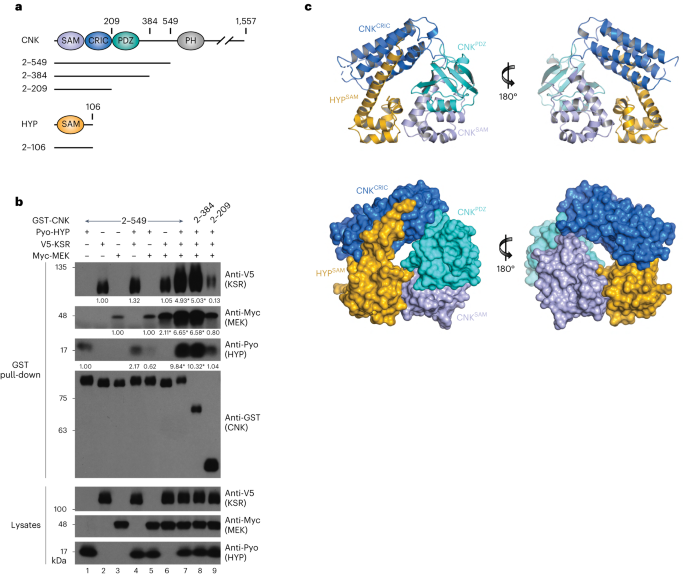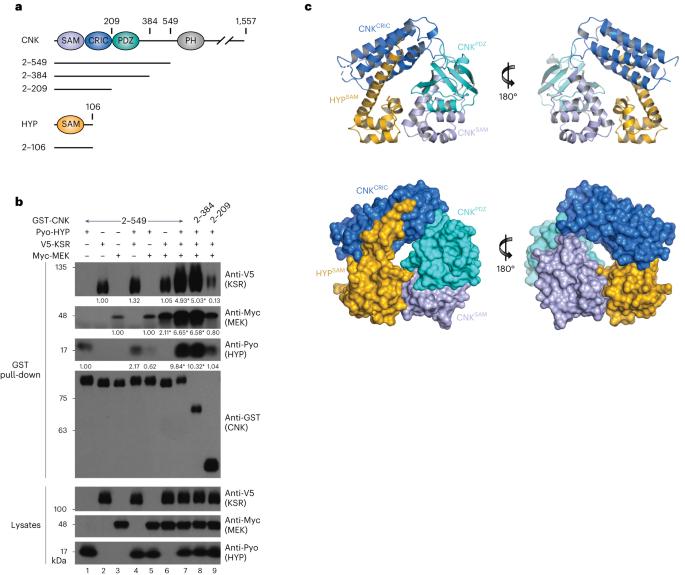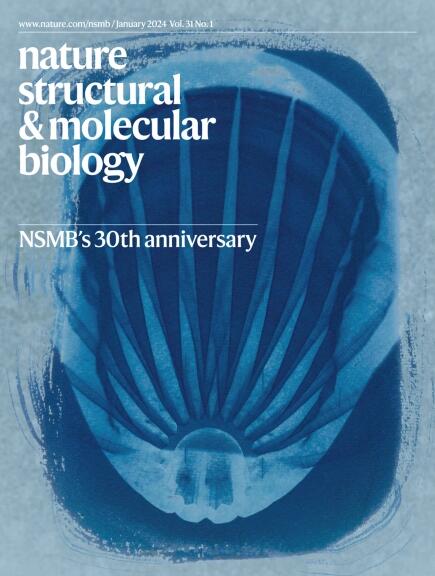The CNK–HYP scaffolding complex promotes RAF activation by enhancing KSR–MEK interaction
IF 12.5
1区 生物学
Q1 BIOCHEMISTRY & MOLECULAR BIOLOGY
引用次数: 0
Abstract
The RAS–MAPK pathway regulates cell proliferation, differentiation and survival, and its dysregulation is associated with cancer development. The pathway minimally comprises the small GTPase RAS and the kinases RAF, MEK and ERK. Activation of RAF by RAS is notoriously intricate and remains only partially understood. There are three RAF isoforms in mammals (ARAF, BRAF and CRAF) and two related pseudokinases (KSR1 and KSR2). RAS-mediated activation of RAF depends on an allosteric mechanism driven by the dimerization of its kinase domain. Recent work on human RAFs showed that MEK binding to KSR1 promotes KSR1–BRAF heterodimerization, which leads to the phosphorylation of free MEK molecules by BRAF. Similar findings were made with the single Drosophila RAF homolog. Here we show that the fly scaffold proteins CNK and HYP stabilize the KSR–MEK interaction, which in turn enhances RAF–KSR heterodimerization and RAF activation. The cryogenic electron microscopy structure of the minimal KSR–MEK–CNK–HYP complex reveals a ring-like arrangement of the CNK–HYP complex allowing CNK to simultaneously engage KSR and MEK, thus stabilizing the binary interaction. Together, these results illuminate how CNK contributes to RAF activation by stimulating the allosteric function of KSR and highlight the diversity of mechanisms impacting RAF dimerization as well as the regulatory potential of the KSR–MEK interaction. Using biochemistry, cell biological, X-ray crystallography and cryo-EM methods, Maisonneuve et al. reveal how the scaffolding proteins CNK and HYP enhance the binding of KSR to MEK, which in turn allosterically controls RAF activation in Drosophila.


CNK-HYP 支架复合物通过增强 KSR-MEK 相互作用促进 RAF 激活
RAS-MAPK 通路调节细胞的增殖、分化和存活,其失调与癌症的发展有关。该通路主要由小 GTP 酶 RAS 和激酶 RAF、MEK 和 ERK 组成。众所周知,RAS 对 RAF 的激活是错综复杂的,目前还只是部分了解。哺乳动物中有三种 RAF 异构体(ARAF、BRAF 和 CRAF)和两种相关的假激酶(KSR1 和 KSR2)。RAS 介导的 RAF 激活取决于其激酶结构域二聚化驱动的异构机制。最近对人类 RAF 的研究表明,MEK 与 KSR1 结合会促进 KSR1-BRAF 异源二聚化,从而导致 BRAF 对游离 MEK 分子进行磷酸化。果蝇的单一 RAF 同源物也有类似的发现。在这里,我们发现果蝇的支架蛋白 CNK 和 HYP 稳定了 KSR 与 MEK 的相互作用,这反过来又增强了 RAF-KSR 的异源二聚化和 RAF 的活化。最小 KSR-MEK-CNK-HYP 复合物的低温电子显微镜结构显示,CNK-HYP 复合物呈环状排列,允许 CNK 同时与 KSR 和 MEK 接触,从而稳定了二元相互作用。这些结果共同揭示了 CNK 如何通过刺激 KSR 的异构功能来促进 RAF 的活化,并强调了影响 RAF 二聚化的机制的多样性以及 KSR-MEK 相互作用的调控潜力。
本文章由计算机程序翻译,如有差异,请以英文原文为准。
求助全文
约1分钟内获得全文
求助全文
来源期刊

Nature Structural & Molecular Biology
BIOCHEMISTRY & MOLECULAR BIOLOGY-BIOPHYSICS
CiteScore
22.00
自引率
1.80%
发文量
160
审稿时长
3-8 weeks
期刊介绍:
Nature Structural & Molecular Biology is a comprehensive platform that combines structural and molecular research. Our journal focuses on exploring the functional and mechanistic aspects of biological processes, emphasizing how molecular components collaborate to achieve a particular function. While structural data can shed light on these insights, our publication does not require them as a prerequisite.
 求助内容:
求助内容: 应助结果提醒方式:
应助结果提醒方式:


